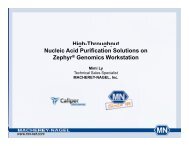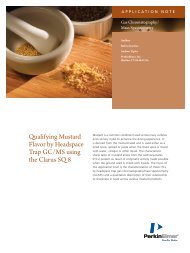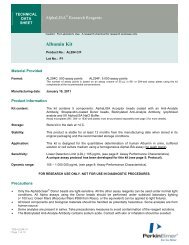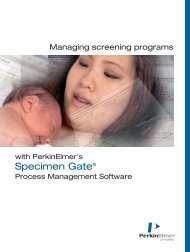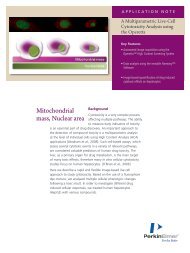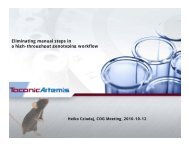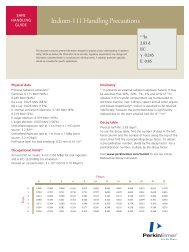DSC as Problem Solving Tool: Measurement of ... - PerkinElmer
DSC as Problem Solving Tool: Measurement of ... - PerkinElmer
DSC as Problem Solving Tool: Measurement of ... - PerkinElmer
You also want an ePaper? Increase the reach of your titles
YUMPU automatically turns print PDFs into web optimized ePapers that Google loves.
Me<strong>as</strong>urement <strong>of</strong> Percent<br />
Crystallinity<br />
As an example <strong>of</strong> the practical<br />
importance <strong>of</strong> knowing the percent<br />
crystallinity <strong>of</strong> polymers, a major<br />
food company recently had<br />
problems with their pl<strong>as</strong>tic ketchup<br />
bottles. Some consumers noted that<br />
the ketchup bottles contained<br />
significantly less ketchup than<br />
specified on the label. The state<br />
authorities were notified and they<br />
verified that the ketchup w<strong>as</strong> not up<br />
to specified levels. The ketchup<br />
bottles from this particular food<br />
company were removed from the<br />
store shelves and the company w<strong>as</strong><br />
fined. It w<strong>as</strong> later found that the<br />
pl<strong>as</strong>tic bottles were defective (due to<br />
a greater concentration <strong>of</strong> recyclates<br />
in the pl<strong>as</strong>tic) and were less<br />
crystalline that they should have<br />
been. The lower crystallinity <strong>of</strong> the<br />
bottle permitted the water in the<br />
ketchup to seep through to the<br />
outside (poor barrier resistance) and<br />
this led to the decre<strong>as</strong>e in the weight<br />
<strong>of</strong> the ketchup inside the bottle.<br />
Testing <strong>of</strong> the pl<strong>as</strong>tic bottles with<br />
<strong>DSC</strong> would have shown that the<br />
bottles were defective with lower<br />
than desired percent crystallinity.<br />
To perform this important<br />
percent crystallinity me<strong>as</strong>urement,<br />
approximately 10 mg <strong>of</strong> the sample<br />
is cut from the test specimen and<br />
accurately weighed. The following<br />
test conditions are used to me<strong>as</strong>ure<br />
the sample’s crystallinity:<br />
Initial<br />
temperature:<br />
Final<br />
temperature:<br />
Heating rate: 10 C/min<br />
Visit our website at www.perkinelmer.com.<br />
<strong>PerkinElmer</strong> Instruments<br />
761 Main Avenue<br />
Norwalk, CT 06859-0010 USA<br />
Tel: 80O-762-4000 or<br />
(1+) 203-762-4000<br />
Fax: (1+) 203-762-4228<br />
Room temperature<br />
30 C above melting<br />
temperature <strong>of</strong><br />
polymer<br />
Purge g<strong>as</strong>: Approximately 10<br />
mg<br />
Sample pan: Crimped aluminum<br />
pan<br />
The heats <strong>of</strong> melting, ΔHm, and<br />
cold crystallization, ΔHc, are<br />
determined by integrating the are<strong>as</strong><br />
(J/g) under the peaks. Depending<br />
upon the sample’s given thermal<br />
history, a cold crystallization<br />
exothermic peak may or may not be<br />
observed during the <strong>DSC</strong><br />
experiment.<br />
The percent crystallinity is then<br />
determined using the following<br />
equation:<br />
% Crystallinity = [ΔHm – ΔHc] / ΔHm°<br />
• 100%<br />
In this equation, the heats <strong>of</strong><br />
melting and cold crystallization are<br />
in terms <strong>of</strong> J/g. The term ΔHm° is a<br />
reference value and represents the<br />
heat <strong>of</strong> melting if the polymer were<br />
100% crystalline. This reference<br />
heat <strong>of</strong> melting h<strong>as</strong> been established<br />
for each <strong>of</strong> the commonly used<br />
polymers and some <strong>of</strong> these are<br />
listed below<br />
Polymer ΔHm° (J/g)<br />
Nylon 6 230.1<br />
Nylon 6,6 255.8<br />
PET 140.1<br />
Polypropylene 207.1<br />
Polyethylene 293.6<br />
The <strong>PerkinElmer</strong> Temperature<br />
Dependent Crystallinity s<strong>of</strong>tware<br />
directly provides these values to<br />
make the <strong>as</strong>sessment <strong>of</strong> the percent<br />
crystallinity more convenient and<br />
e<strong>as</strong>ier.<br />
©2000 <strong>PerkinElmer</strong>, Inc. Printed in U.S.A.<br />
Percent Crystallinity Results from<br />
PET Container<br />
Polyethylene terephthalate (PET) is<br />
widely utilized for the production <strong>of</strong> food<br />
and beverage containers. PET bottle<br />
resins provide good impact resistance,<br />
good optical clarity and barrier resistance,<br />
provided that the resin achieves a proper<br />
percent crystallinity during production.<br />
PET containers are manufactured using a<br />
blow molding process where the resin is<br />
melted, injected into a mold were the resin<br />
<strong>as</strong>sumes the temporary shape <strong>of</strong> a tube.<br />
Pressurized air is then introduced into the<br />
tube, which then expands the shape <strong>of</strong> the<br />
container to its final form. As this occurs,<br />
the resin acquires a certain level <strong>of</strong><br />
crystallinity which then affects the final<br />
properties <strong>of</strong> the container including<br />
optical clarity, g<strong>as</strong> permeability, impact<br />
resistance, stiffness, resistance to creep,<br />
etc.<br />
Displayed in Figure 1 are the <strong>DSC</strong><br />
results, generated on the <strong>PerkinElmer</strong><br />
Pyris 6 <strong>DSC</strong> instrument, for an ‘<strong>as</strong>received’<br />
PET container.<br />
The <strong>as</strong>-received bottle resin shows<br />
three distinct transitions, all <strong>of</strong> which<br />
are key to the properties exhibited by<br />
the container:<br />
Tg or gl<strong>as</strong>s transition at 75 C<br />
where the resin undergoes s<strong>of</strong>tening<br />
Cold crystallization at 101 C (ΔHc<br />
= 1.65 J/g) where the polymer<br />
undergoes some small amount <strong>of</strong><br />
crystallization while heating in the<br />
<strong>DSC</strong><br />
Melting at 247 C (ΔHm = 46.5 J/g)<br />
where the existing crystalline<br />
component is destroyed<br />
The percent crystallinity <strong>of</strong> this<br />
particular PET food container can be<br />
<strong>as</strong>sessed b<strong>as</strong>ed on these <strong>DSC</strong> results<br />
and b<strong>as</strong>ed on the theoretical heat <strong>of</strong><br />
melting for 100% crystalline PET:<br />
PETech-40<br />
Thermal Analysis



